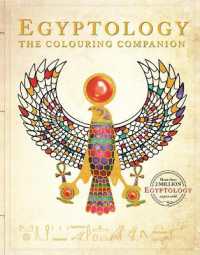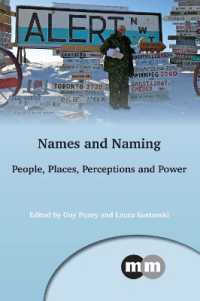- ホーム
- > 洋書
- > 英文書
- > History / World
Full Description
New Guinea, and especially Papua New Guinea, is the last country in the world where ethnologists were able to closely observe, film and photograph the whole manufacturing chaînes opératoires of polished stone felling tools, from quarry extraction to finished tool use. Research on the polished blades of PNG has evolved over the years, following changing philosophies and research agendas. While it is clear that an exceptional sum of information has been gathered, it remains centered on that small part of the Highlands where conditions for field research were more pleasant than elsewhere. Our presentation of Irian Jaya axes therefore tackles a topic that remains mostly unexplored. Until now, stone tool research in New Guinea has followed an anthropocentric approach, in which tools are seen more as vectors for social exchanges than as means of acting on the environment.
This monograph will take a different approach. Here, polished stone blades are placed at the center of the world, between, on one side, the transformed natural environment, and, on the other, the social and economic environment. This approach will allow us to suggest new avenues of inference in archaeology, as well as to test and abandon existing ones.In this volume, the stone blade is considered as a living being, existing in balance within its biotope. This idea is not far removed from the beliefs of Irian Jaya farmers, for whom life animates certain objects of their material culture.
Following a brief presentation of Irian Jaya, we will describe the function of polished stone blades in Irian Jaya societies and the distribution of hafting styles, define and study the quarrying zones and the areas of diffusion and use of their production, and, if possible, the different trends noted in each area of polished blade production and exchanges. Finally, we will conclude with a discussion of the ethnoarchaeological potential of these contemporary observations.
Contents
Acknowledgements
Preface (by Polly Wiessner)
Introduction
Foreword to the English edition
1. Polished stone blades as means of social and technical reproduction
1.1. An island open to global economies
1.2. Raw material determinisms
1.3. Axes and Adzes
2. The Yeleme quarries (Kp. Paniai) and the polished blades of Central Irian Jaya
2.1. Rocks from the upper Ye-I River
2.2. The Wang-Kob-Me quarry
2.3. The Brahire quarry in Ye-Ineri
2.4. Blocks from the bed of the Ye-I River
2.5. From roughout to axe in Wano country
2.6. The Axe Trail
2.7. Accessing roughouts: the Yamo Dani perspective
2.8. From roughout to axe among the Yamo Dani
2.9. The expansion of the Western Dani and the acceleration of exchanges
2.10. The Baliem and the realm of adzes
2.11. Axes and adzes, the prestige of stone blades
2.12. Partners and strangers: the limitation of exchanges
3. Material and social techniques of the Dani: black rocks and greenschists
3.1. The black rocks of Gomburu (Kp. Paniai)
3.2. The black rocks of Tagi (Kp. Jayawijaya)
3.3. Black rock axes and sacred objects
3.4. The quarries of Awigobi and greenschist blades
3.5. Ye-yao, the exchange axes
4. Adzes of the Eastern Highlands (Kp. Jayawijaya)
4.1. From rock to adze in Langda
4.2. Stone blade production in the Phu Valley and the westward expansion of adzes
4.3. Yamyhl, Red Digul and the Seashell Trail
5. Ormu-Wari and the Lowland axes
5.1. The Mumugo Valley and schist axes
5.2. Ormu and marriage axes
6. The polished blades of Irian Jaya, a synthesis
6.1. A shared background: the balance between natural environment, modes of
subsistence and population density
6.2. Rocks and types of sources
6.3. Quarry access and the social context of quarrying
6.4. Quarrying techniques
6.5. Duration of the quarrying events
6.6. From rock to polished blade: segmentation of the chaîne opératoire
6.7. Shaping roughouts: raw material determinisms
6.8. Manufacture and specialization
6.9. Polishing and polishing stones
6.10. Axes and adzes
6.11. Intensity of polishing
6.12. Length of the stone blades
6.13. Handles for felling tools
6.14. Circulation of the blades
6.15. Stone blades for the living
7. Postface








